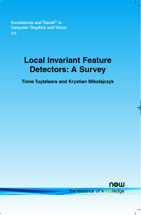Local Invariant Feature Detectors: A Survey
By Tinne Tuytelaars, Department of Electrical Engineering, Katholieke Universiteit Leuven, Belgium, Tinne.Tuytelaars@esat.kuleuven.be | Krystian Mikolajczyk, School of Electronics and Physical Sciences, University of Surrey, UK, K.Mikolajczyk@surrey.ac.uk
Abstract
In this survey, we give an overview of invariant interest point detectors, how they evolved over time, how they work, and what their respective strengths and weaknesses are. We begin with defining the properties of the ideal local feature detector. This is followed by an overview of the literature over the past four decades organized in different categories of feature extraction methods. We then provide a more detailed analysis of a selection of methods which had a particularly significant impact on the research field. We conclude with a summary and promising future research directions.
Local Invariant Feature Detectors
Local features are a popular tool for image description nowadays. They are the standard representation for wide baseline matching and object recognition, both for specific objects as well as for category-level schemes.
Local Invariant Features Detectors examines some of the most widely used detectors, with a qualitative evaluation of their respective strengths and weaknesses, which can be found at the end of the sections and chapters. It also puts the work on local feature detection in context, by summarizing the progress in feature detection from the early days of computer vision up to now. It goes on to provide a more detailed analysis of a selection of more recent methods which have had a particularly significant impact on the research field.
Local Invariant Features Detectors is an ideal starting point for anyone interested in the topic. It also points the way for those who want to delve deeper.
